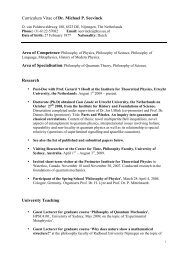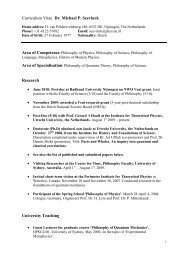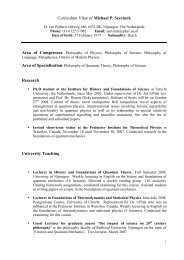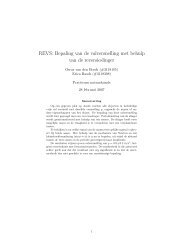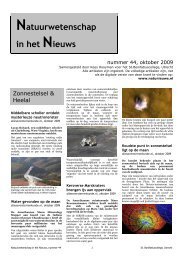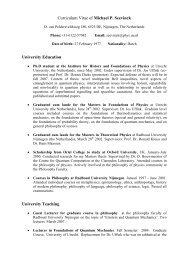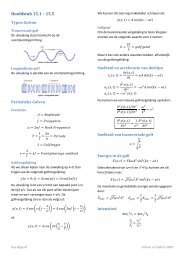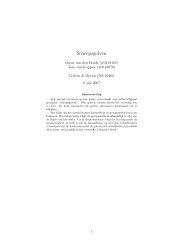Exercise sheet 2: 10 Mar
Exercise sheet 2: 10 Mar
Exercise sheet 2: 10 Mar
Create successful ePaper yourself
Turn your PDF publications into a flip-book with our unique Google optimized e-Paper software.
(a) What should the asymptotics (r → ∞) of A(r) and B(r) be for the metric to look<br />
like Minkowski space for large r?<br />
(b) Show that the non-vanishing Christoffel symbols are (up to symmetry in the lower<br />
indices)<br />
Γ r tt = A′ Γ t 2B rt = A′<br />
2A Γr rr = B′<br />
Γ r 2B θθ = − r Γ θ B rθ = 1 r<br />
Γ r φφ = − r sin2 θ<br />
Γ φ B rφ = 1 Γ θ r φφ = − sin θ cos θ Γ φ θφ = cot θ (7)<br />
(c) Show that the non-vanishing components of the Ricci tensor are<br />
R tt = 1 (<br />
A ′′ − A′ B ′<br />
2B 2B − (A′ ) 2 )<br />
2A + 2A′ ,<br />
r<br />
R rr = 1 (<br />
−A ′′ + (A′ ) 2<br />
2A 2A + A′ B ′ )<br />
2B + 2AB′ , (8)<br />
rB<br />
R θθ = 1 − 1 (<br />
)<br />
1 + rA′<br />
B 2A − rB′ ,<br />
2B<br />
and R φφ (but you do not need to calculate R φφ ).<br />
(d) Applying the vacuum Einstein equations R µν = 0, we get an (overdetermined) system<br />
of differential equations. Show that a solution must satisfy (AB) ′ = 0 and (r/B) ′ = 1<br />
and therefore (taking into account the asymptotics) must be of the form<br />
for some constant M.<br />
A(r) = 1 − 2M r ; B(r) = (<br />
1 − 2M r<br />
) −1<br />
, (9)<br />
4. Tolman-Oppenheimer-Volkoff equations. We consider the metric ansatz (6) from the<br />
previous exercise but this time we will impose Einstein’s equations with a non-vanishing<br />
stress-energy tensor T ν µ = diag(ρ(r), −p(r), −p(r), −p(r)).<br />
(a) Write Einstein’s equations (with G = c = 1) in the form R µν = −8π(T µν − 1 2 g µνT )<br />
and derive the equations for R tt , R rr and R θθ .<br />
(b) Using (8), show that<br />
M ′ (r) = r2<br />
4 (R tt<br />
A + R rr<br />
B ) + 1 2 R θθ = 4πr 2 ρ (<strong>10</strong>)<br />
where we defined M by B = (1 − 2M/r) −1 .<br />
(c) Use the energy momentum conservation D ν T ν µ = 0 and (7) to derive<br />
dp<br />
dr<br />
= −(ρ + p)A′<br />
A = −(ρ + p)(M + 4πpr3 )<br />
. (11)<br />
r 2 (1 − 2M/r)<br />
2



